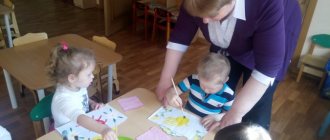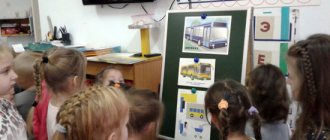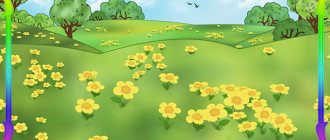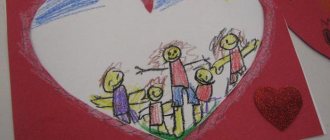Exciting activities for children aged 3 to 4 years in drawing with colored pencils, gouache and watercolors in traditional and non-traditional ways develop aesthetic perception. Kindergarten is the best place for developing emotional responsiveness, cultivating a sense of beauty, developing imagination, independence, perseverance, accuracy, hard work, and developing visual skills.
Fine arts lesson on the topic “Planes are flying” in junior kindergarten groups
Before preparing a lesson for children in the younger groups of kindergarten, you need to choose an interesting topic. In the process of visual activity, children must reflect life impressions. Drawing in the second junior group “Planes are flying” teaches you to depict objects and phenomena that form clear ideas about the environment.
Fine art lesson on the topic “Planes are flying” for younger groups
Example of drawing lesson notes
The program content should contain children's material, which must be conveyed in a drawing, reflecting the phenomena of modern life. Kids can draw airplanes flying in the sky. In addition, children should learn to draw straight lines in different directions when drawing objects related to flight. This technique contributes to the development of aesthetic perception.
On the topic: methodological developments, presentations and notes
Date: February 21, 2012 Participants: children of the preparatory group Conducted by: educational psychologist Panova M.M. Purpose: to promote formation.
Introduce children to number and figure 6. Improve counting skills and comparison of subject aggregates. Form children’s ability to distinguish between the concepts of yesterday, today, tomorrow. Consolidate knowledge about geome.
The lesson “An exciting trip on a traffic police helicopter” is aimed at strengthening children’s knowledge of familiar traffic rules.
Goal: - To develop practical skills in working with a variety of natural materials. - When making a toy, to teach how to measure its parts. - To develop children’s imagination and desire to make toys.
Summary of a lesson on artistic and aesthetic education for children of senior preschool age on the topic: “Drawing a military helicopter.”
Source
Lesson Objectives
The main task is to form a self-sufficient, multifaceted, creative personality. Drawing for the 2nd junior group “Planes are flying” promotes the development of creative and cognitive activity and the enrichment of new knowledge. The child begins to get acquainted with the world around him.
Important! If you use non-standard materials and techniques, then you can easily interest children in visual arts. This method turns the process into an interesting hobby.
Airplane drawing problems
Educational tasks:
- develop the ability to listen carefully to the teacher’s explanation;
- cultivate positive emotions from classes and free motor activity;
- develop the ability to interact and establish contacts with adults and each other through speech;
- cultivate interest in drawing and evoke an emotional response.
Developmental tasks:
- develop the ability to independently and at the request of an adult take part in conversations;
- increase curiosity and cognitive interest in transport objects;
- develop fine motor skills, auditory perception, clarify and consolidate the articulation of the sound “u”;
- promote the development of skills in expressive and emotional transmission of game images.
March
Lesson 61. Application “Flags”
Program content.
Strengthen the ability to create in an application an image of a rectangular object consisting of two parts; correctly position an object on a sheet of paper, distinguish and correctly name colors; Use the glue carefully and spread it all over the mold. Develop the ability to enjoy the overall result of the lesson.
Lesson 62. Drawing “Beautiful flags on a string”
(Option “Spatulas for dolls”)
Program content.
Teach children to draw rectangular objects using separate vertical and horizontal lines. Introduce the rectangular shape. Continue to practice drawing and coloring techniques with colored pencils.
63. Modeling “Tumbler”
Program content.
Teach children to sculpt an object consisting of several parts of the same shape, but of different sizes, pressing the parts tightly against each other. Create a desire to decorate an object with small details (a pompom on a hat, buttons on a dress). Clarify children's ideas about the size of objects. Strengthen the ability to sculpt accurately. Create a feeling of joy from what you have created.
Lesson 64. Modeling “Little Masha”
(Based on a nursery rhyme)
Program content.
Teach children to sculpt a small doll: the fur coat is a thick column, the head is a ball, the hands are sticks. Strengthen the ability to roll out clay with straight movements (column - coat, sticks - sleeves) and circular movements (head). Learn to compose an image from parts. Invoke a feeling of joy from the resulting image.
Lesson 65. Drawing “Draw someone who wants something beautiful”
Program content.
Develop aesthetic perception. Learn to see and highlight beautiful objects and phenomena. Strengthen children's ability to draw with different materials, choosing them as they wish.
Lesson 66. Modeling “Treats for dolls, bears, bunnies”
Program content.
To develop children’s ability to choose the content of their modeling from the named objects. Foster independence. Reinforce sculpting techniques. Create a desire to sculpt something needed for the game. Develop imagination.
Lesson 67. Drawing “Baby Books”
Program content.
Teach form-building movements of drawing quadrangular shapes with a continuous movement of the hand from left to right, from top to bottom, etc. (you can start the movement from any side). Clarify the technique of painting by moving your hand from top to bottom or from left to right. Develop imagination.
Lesson 68. Application “Napkin”
Program content.
Learn to make a pattern of circles and squares on a square-shaped paper napkin, placing the circles in the corners of the square and in the middle, and the squares
between
them. Develop a sense of rhythm. Strengthen the ability to glue parts carefully.
Lesson 69. Drawing “Draw something rectangular in shape”
Program content.
Teach children to independently think about the content of the drawing, to apply the acquired skills in depicting various rectangular objects. Learn to select pencils of the right colors for drawing. Practice drawing and painting rectangular objects. Develop a sense of color and imagination.
Lesson 70. Modeling “Tumbler Bear”
Program content.
Exercise children in depicting objects consisting of round parts of different sizes. Practice the ability to fasten parts of an object, pressing them tightly against each other.
Materials and equipment needed for the lesson
Materials and equipment to perform the work
For the lesson to go perfectly, you need to select a sheet of light blue paper, light gray gouache paints, brushes, jars of water, paper and cloth napkins, an easel, a toy aircraft, pictures of an airliner, a poster with flying planes.
Two toy airplanes are suitable as demonstration material.
For your information! From the handouts, it is recommended to prepare a large sheet of paper on which the flight of an airliner is depicted.
January
Lesson 41. Drawing “New Year tree with lights and balls”
Program content.
Teach children to convey the image of an elegant Christmas tree in a drawing; draw a Christmas tree large, on the entire sheet; decorate it using techniques of dipping, drawing round shapes and lines. Develop aesthetic perception, form imaginative ideas. Introduce pink and blue flowers. Induce a feeling of joy from beautiful drawings.
Lesson 42. Drawing “Let’s decorate the house mitten”
(Integrated lesson based on theatrical performance)
Program content.
Teach children to draw based on the fairy tale “The Mitten”, to create a fairy-tale image. Develop imagination and creativity. Develop the ability to decorate an object. Strengthen the ability to use paints of different colors in the process of drawing; Rinse the brush clean and dry it on a cloth before using another paint.
Lesson 43. Modeling “Tangerines and Oranges”
Program content.
Strengthen children's ability to sculpt round objects by rolling the clay in a circular motion between their palms. Learn to sculpt objects of different sizes.
Lesson 44. Drawing “Let's decorate the Dymkovo duck”
Program content.
Continue to introduce children to the Dymkovo toy. Learn to highlight painting elements and apply them to a duck cut out of paper. Cause joy from the resulting result; from the brightness and beauty of Dymkovo painting.
Lesson 45. Application “Beautiful napkin”
Program content.
Teach children to make a pattern on square paper, placing large circles of the same color in the corners and in the middle, and small circles of a different color in the middle of each
side
. Develop compositional skills, color perception, aesthetic feelings.
Lesson 46. Drawing by design
Program content.
Teach children to think about the content of the drawing and use learned drawing techniques. Learn to fill the entire sheet with images. Create a desire to look at the drawings and discuss them; enjoy colorful images and their diversity.
Lesson 47. Modeling “Delicious gifts for Mishka’s birthday”
Program content.
Develop imagination and creativity. Teach children to use familiar sculpting techniques to create different images. Reinforce sculpting techniques; Ability to handle materials and equipment carefully.
Lesson 48. Application “Snowman”
Program content.
To consolidate children's knowledge about round shapes and the differences in size of objects. Learn to compose an image from parts, arranging them correctly in size. Practice careful gluing.
Lesson 49. Modeling “Little dolls walking in a snowy meadow”
Program content.
Learn to create the image of a doll in modeling. Learn to sculpt an object consisting of two parts: a column (fur coat) and a round shape (head). Strengthen the ability to roll clay between the palms with straight and circular movements, connect two parts of an object using pressing techniques.
Lesson 50. Modeling “Make your favorite toy”
Program content.
Teach children to independently choose the content of modeling and use previously learned modeling techniques. Strengthen the ability to sculpt objects consisting of one or several parts, conveying their shape and size. Invoke joy from the created image.
Preliminary work with children, discussion of the topic
At the first stage, the image of the aircraft is examined, the idea of the features of the appearance of the airliner (flying in the sky, through the air) is clarified. In addition, it is possible to sculpt an airplane and read a fairy tale.
Demonstration of materials
Which image to choose for printing on paper
Before choosing a sample to put on paper, the teacher introduces the children to the world of art. This method serves to develop a basic understanding of works of decorative and applied art and architecture. The teacher invites the kids to look at the template - an airplane.
The theme of the week is “Book Week” in the senior and preparatory groups
Progress of the Lesson:
Q. Guys, the holiday “Defender of the Fatherland Day” is coming soon. Why is it called that? Who can we call defenders of the fatherland?
Q. But to defend the Motherland you need special equipment. Guess the riddle:
it looks like an all-terrain vehicle,
will pass through mud easily,
hill, ditch is not a barrier,
will instantly rush as it should. (tank)
The bird flies across the sky, but does not move its wing.
makes a wonderful flight ( plane )
Guys, look at the plane (showing a toy plane )
.
An airplane has a body , wings, and a tail.
Let's try to make a plane out of magic pebbles.
We'll build the plane ourselves,
let's fly over the forests,
let's fly over the forests,
and then we’ll go back to mom.
Now look at how to draw an airplane . You need to take a pencil and hold it with three fingers. Like this. First we draw the body of the aircraft . Like this, in a straight line (I show)
Now we draw the wings.
I draw straight lines on the sides of the aircraft . Like this (I show)
at a slight angle.
Draw the tail from the end of the airplane body upwards , to the side. Like this (I draw on an easel)
.
Now let’s show in the air with our finger the order in which to draw the plane . (Together with the children I show with a gesture, and we say with the children again: body, wings, tail of the plane ).
Admire your planes , how beautiful they turned out. How beautifully they fly in the sky . Well done!
Summary of the integrated lesson “Hello, autumn!” (second junior group) Summary of the integrated lesson 2nd junior group “Hello autumn!” Objectives: Expand children's understanding of seasonal natural phenomena. Summary of the integrated lesson “Geese-swans” (second junior group) Purpose. Consolidating children's knowledge of the material covered on FEMP and speech development. Objectives: Educational: 1. Strengthen the ability to determine. Summary of the final lesson on FEMP “Journey to the Fairytale Forest” (second junior group) Purpose: to consolidate the concepts of many, one; train the ability to compare the number of objects: “more”, “less”, “the same”; secure.
Summary of the music lesson “Acquaintance with musical instruments” (second junior group) Synopsis of the musical lesson “Acquaintance with musical instruments” Second junior group Program content • Learning objectives:.
"Maple twig." Notes on non-traditional drawing using the technique of “imprint, imprint with leaves” (second junior group) Notes on the lesson “Maple Twig” using the method of unconventional drawing Technique “Imprint. Imprint with leaves" Educational.
Source
Questions for children based on their drawings
At the end of the lesson, the teacher can ask the children questions to reinforce the material:
- Children, what did you draw?
- How did you draw airplanes?
- Did you like drawing the plane?
The teacher asks questions to the children based on their drawings
When creating a drawing, kids should imagine the surrounding objective world. And thematic lessons play an important role in this. Drawing on the theme “Planes are flying” is an excellent choice for developing imagination and increasing children’s interest. The main thing is to praise the young artists at the end of the lesson, even if they didn’t do everything right.
Progress of the lesson:
Q: Guys, today on the way to kindergarten I met Sasha from a neighboring group , and he was very sad. to draw an airplane for his birthday , but did not have time. Let's help him draw .
Q: When you and I were walking, we saw planes flying in the sky . The planes flew smoothly , beautifully in a clear, bright blue sky or among white fluffy clouds. When the sun illuminated the plane , it sparkled beautifully. An airplane is the fastest mode of transport. All planes arrive and depart from the airfield. Who flies the planes ?
D: pilots, pilots.
Q: There are passenger and combat aircraft .
Guys, look at the plane (showing a toy plane )
.
An airplane has a body , wings, and a tail.
Now look at how to draw an airplane (children approach the easel)
.
You need to take a brush and hold it with three fingers at the iron tip. Like this. Place it in a jar of paint, remove excess paint from the edge of the jar and paint with the whole brush . First the aircraft . Like this, in a straight line (I show)
Then put paint on the brush again.
Now I'm drawing the wings. I draw straight lines on the sides of the aircraft . Like this (I show)
at a slight angle.
I pick up the paint again and draw the tail from the end of the plane's body upwards , to the side. Like this (I draw on an easel)
.
Now let’s show in the air with our finger the order in which to draw the plane . (Together with the children I show with a gesture, and we say with the children again: body, wings, tail of the plane ).
Q: Well, now, let’s relax before work and sing a song about an airplane .
The plane is flying , the plane is buzzing ,
U-U-U-U I'm flying to Moscow (arms to the sides, alternately tilting to the right and left)
.
Commander pilot, the plane is flying ,
U-U-U-U, I'm flying to Moscow. (rotate your arms in front of you)
.
Q: Well, now take your seats and start drawing . (Children do the work)
.
Q: Oh, guys, what beautiful planes you drew . How many of them did you get?
Q: What do planes do ?
D: They're flying !
Q: Let us also fly on airplanes (the teacher invites the children onto the carpet)
We get on the plane , (Children crouch)
Let's take flight! ( They “start”
the plane , stand up and say: “zhu”
)
We are flying above the clouds. (Hands to the side)
We wave to dad, we wave to mom. (Take turns with both hands)
We see how the river flows (they show waves with their hands)
We see a fisherman's boat. ( "Abandoned"
fishing rod)
Be careful: the mountain! (Lean to the left, to the right, say: “zhu”
)
It's time for us to land! (Squat)
Q: Guys, what did we do today? Who did they help? Did you like it? Well done! Admire your planes , how beautiful they turned out. How beautifully they fly in the sky . Now Sasha’s friend will not be left without a gift. Well done!
GCD summary for application in the second junior group “Flying Airplanes” GCD summary for application in the second junior group “Flying Airplanes” Author: Olga Mikhailovna Yudina, teacher. Place of work: Children's preschool educational institution.
Preview:
Abstract of the educational activity “Planes are flying”
watching a plane flying in the sky, looking at pictures, illustrations, reading stories, poems, playing with toys
Equipment and materials: toy airplane, landscape sheets of paper with images of clouds and the silhouette of an airplane body, blue and white paints, brushes, cotton swabs, jars, stands for brushes.
Goal: To consolidate the ability to draw objects consisting of several parts
Today I invite you to go on a journey together. And on what? This is my secret. Do you want to know? To do this, I propose to guess the riddle:
It's not a crane rushing in the sky,
Takes its flight
How did you quickly guess (shows the toy, performs a “flight” with it). What a wonderful bird!
And what is it? (points to wings)
What do you think they are for?
Children: to fly, keep balance
This is a building (points to the building, the children repeat the new word)) and passengers sit here.
-Teacher: What is this?
These are portholes (repeat). What are they needed for?
Children: look at the clouds, at the sun, at what is visible during takeoff and landing.
How many of you have flown on an airplane? (children raise their hands)
Today I invite you to become pilots and go on a plane trip. Do you agree?
But where will we get the plane?
Well done boys! We'll draw it ourselves!
Look at your sheets - what is your plane missing?
Children: the wings, windows and the plane need to be painted.
Now I will show you how to finish drawing the wings (shows on the sample). Let's try to draw such wings in the air. (Reminds how to hold a brush correctly)
Children add blue paint to the wings of the plane, then paint the plane.
Let's fly, fly, (legs stand apart)
Spin your arms forward (rotate your arms in front of your chest)
Hands to the sides - fly
We send the plane, (spread your arms horizontally to the sides)
Right wing forward (turn the body to the right with the right arm moving forward)
Left wing forward. (turn the torso to the left with the left arm moving forward)
One two three four -
Our plane took off.
The plane was sent on its way. (random running with arms out to the sides)
During physical education, the paint on the drawings dries out. Children use a cotton swab to pick up white paint and, by dabbing, paint the windows, then draw the pilot's window.
Guys, what beautiful planes you have created! Now you and I can go on a journey! (conducts the outdoor game “Journey”):
— All “pilots” and “passengers”, please take your seats. We set off on a flight (children, together with the teacher, “travel” through the group, imagining mountains and seas, cities and deserts).




